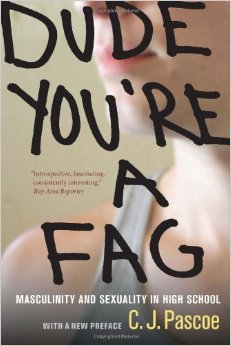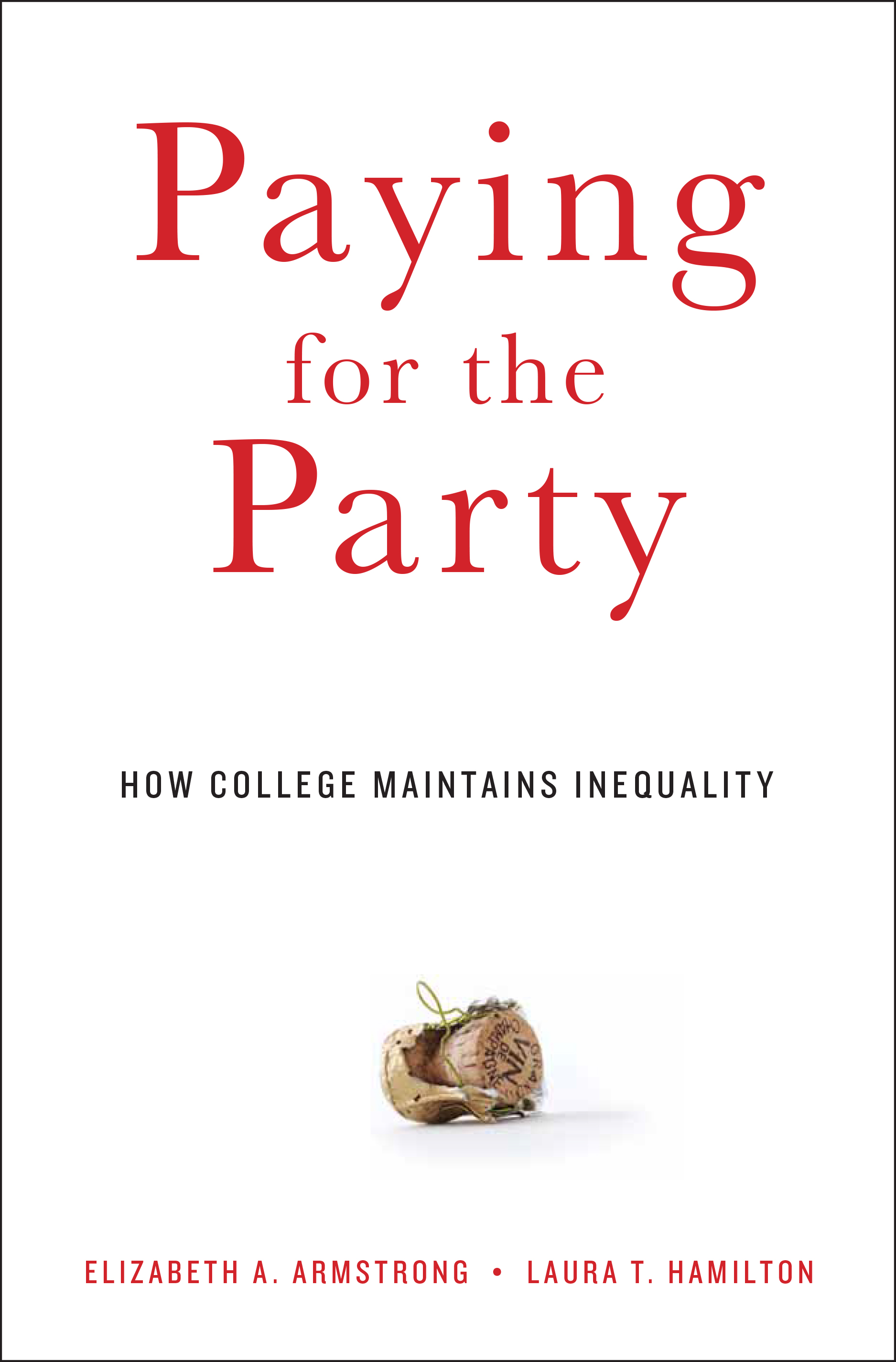“The fag” and “the slut” are both symbols of contemporary gender relations. Stories about each provide social mechanisms for bonding, betraying, and belonging. Research suggests that “fag” and “slut” are among the more ubiquitous insults traded among young people. Each is simultaneously all about sexuality and has absolutely nothing to do with sexuality. For instance, most of CJ Pascoe’s research participants in her study of the use of “fag” among boys at River High said that they would never aim the insult at someone who is “actually gay.” Pascoe suggests that this indicates a need for a more nuanced way of understanding sexuality—not as some thing inhering in specific bodies or identities, but as something capable of operating to discursively construct social boundaries in social life as well. “Slut” is used in similar ways—as a mechanism of gender policing. Most of the research focusing on either is primarily about gender policing and gender and sexual inequality. But, research shows that sexual discourses play a key role in racial and class inequality as well.
 Pascoe discovered that “homophobia” didn’t fully explain exactly what she observed at River High. It was a gendered and racialized form of homophobia that Pascoe refers to as “fag discourse.” Fag discourse is all about drawing boundaries around acceptable masculinity. Boys hurled the insult at each other in jest, sometimes at random, and as a part of a social game—one in which they were incredibly invested. But it was a “game” primarily played among white boys at River High. There’s a whole section of her book dedicated to “Racializing the Fag” that explores the intricacies of this interesting nuance associated with fag discourse. At River High, Black boys and white boys rely on distinct symbolic resources when “doing gender.” For instance, paying “excessive” attention to one’s clothing or identifying with an ability to dance well put white boys at risk of being labeled a “fag,” but worked to enhance Black boys’ masculine status. Pascoe also discovered that Black boys were unable to rely on fag discourse in quite the same way that white boys did. Indeed, though they were much less likely to use the term, Black boys at River High were much more likely to be punished by school authorities when they did. Black boys were also the only students reported to school authorities for saying “fag” by their peers. White boys, in other words, relied on racial hierarchies to control the meaning of the discourse such that saying “fag” was interpreted as “playful” and “meaningless” when they used the term and “dangerous” and “harassing” when Black boys did.
Pascoe discovered that “homophobia” didn’t fully explain exactly what she observed at River High. It was a gendered and racialized form of homophobia that Pascoe refers to as “fag discourse.” Fag discourse is all about drawing boundaries around acceptable masculinity. Boys hurled the insult at each other in jest, sometimes at random, and as a part of a social game—one in which they were incredibly invested. But it was a “game” primarily played among white boys at River High. There’s a whole section of her book dedicated to “Racializing the Fag” that explores the intricacies of this interesting nuance associated with fag discourse. At River High, Black boys and white boys rely on distinct symbolic resources when “doing gender.” For instance, paying “excessive” attention to one’s clothing or identifying with an ability to dance well put white boys at risk of being labeled a “fag,” but worked to enhance Black boys’ masculine status. Pascoe also discovered that Black boys were unable to rely on fag discourse in quite the same way that white boys did. Indeed, though they were much less likely to use the term, Black boys at River High were much more likely to be punished by school authorities when they did. Black boys were also the only students reported to school authorities for saying “fag” by their peers. White boys, in other words, relied on racial hierarchies to control the meaning of the discourse such that saying “fag” was interpreted as “playful” and “meaningless” when they used the term and “dangerous” and “harassing” when Black boys did.
 In a separate study of sexuality in college life, Elizabeth A. Armstrong, Laura T. Hamilton, Elizabeth M. Armstrong, and J. Lotus Seely investigated the meaning of the term “slut” among college women. This paper is a part of Armstrong and Hamilton’s larger research project and book, Paying for the Party: How College Maintains Inequality. Armstrong et al. discovered that “slut” had a fluid meaning for college women. Not all of them understood the same sorts of behavior as putting someone at risk of receiving the insult. At the institution at which the study was conducted, they found that social status among women fell largely along class lines. “High-status” women were almost entirely upper and upper-middle class. This was at least partially due to the fact that performing the femininity necessary for classification required class resources (joining a sorority, having the “right” kind of body, hair, clothes, etc.).
In a separate study of sexuality in college life, Elizabeth A. Armstrong, Laura T. Hamilton, Elizabeth M. Armstrong, and J. Lotus Seely investigated the meaning of the term “slut” among college women. This paper is a part of Armstrong and Hamilton’s larger research project and book, Paying for the Party: How College Maintains Inequality. Armstrong et al. discovered that “slut” had a fluid meaning for college women. Not all of them understood the same sorts of behavior as putting someone at risk of receiving the insult. At the institution at which the study was conducted, they found that social status among women fell largely along class lines. “High-status” women were almost entirely upper and upper-middle class. This was at least partially due to the fact that performing the femininity necessary for classification required class resources (joining a sorority, having the “right” kind of body, hair, clothes, etc.).
Armstrong, et al. found that high-status women used “slut” to refer to a specific configuration of femininity, one they defined as “trashy.” While high-status women rarely actually deployed classist language, their comments relied on understandings of performance of gender stereotypically associated with less-affluent women—what Mimi Schippers would refer to as “pariah femininities”—and allowed them to situate their own sexual behavior and identities as beyond reproach. Similar to Julie Bettie’s study of white and Mexican-American girls, Armstrong et al. found that performing “classy” or “preppy” femininity (a performance that is simultaneously gendered, raced, sexualized, and classed) worked to shield high-status women from “slut” stigma. The low-status women in Armstrong et al.’s study understood “slut discourse” to be more about sexuality than gender. Situating themselves as outside of the alleged “hookup culture,” low-status women used “slut” to stigmatize the sexual behavior of high-status women (sex outside of relationships). In an analogous way to Pascoe’s findings regarding race and fag discourse, these classed differences involving women drawing moral boundaries around femininity were enforced unevenly. While both groups reconstituted “slut” to work to their advantage, casual sexual activity posed little reputational risk for high-status women, so long as they continued to perform a “classy” configuration of femininity in the process. Similar to Pascoe’s research, high-status women here relied on symbolic class boundaries to control the meaning of the discourse such that participation in casual sexual interactions took on a different meaning when coupled with “classy” performances of gender. Here, class worked to insulate high-status women just as race worked to insulate white boys in Pascoe’s research.
Both studies illustrate important intersections between sexuality, race and class. Sexual discourses are invoked in a variety of ways throughout social life. They play an integral role in policing gender boundaries. But it is also important to continue to consider the role that sexual discourses play in bolstering boundaries around race and class.
